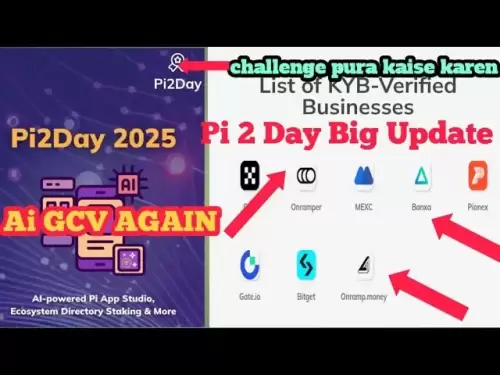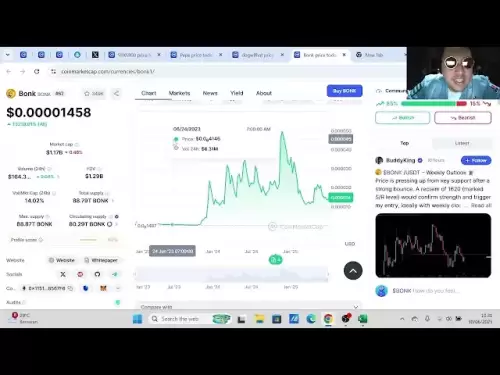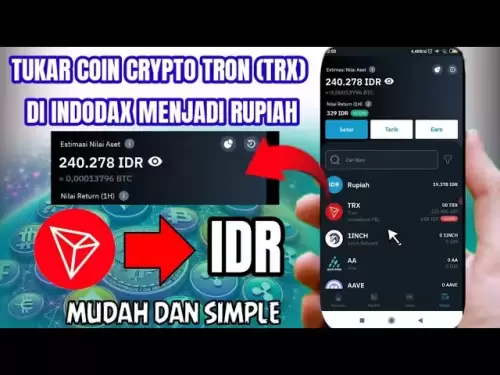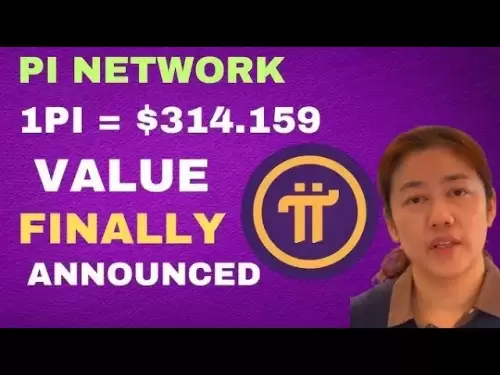-
 Bitcoin
Bitcoin $108,489.6704
1.13% -
 Ethereum
Ethereum $2,502.0528
2.92% -
 Tether USDt
Tether USDt $1.0002
0.00% -
 XRP
XRP $2.1941
0.51% -
 BNB
BNB $655.3375
1.00% -
 Solana
Solana $151.5977
1.27% -
 USDC
USDC $0.9999
0.00% -
 TRON
TRON $0.2768
0.32% -
 Dogecoin
Dogecoin $0.1676
2.86% -
 Cardano
Cardano $0.5675
0.98% -
 Hyperliquid
Hyperliquid $40.6109
7.48% -
 Bitcoin Cash
Bitcoin Cash $500.7746
2.09% -
 Sui
Sui $2.8328
2.03% -
 Chainlink
Chainlink $13.4452
1.26% -
 UNUS SED LEO
UNUS SED LEO $9.1623
0.39% -
 Avalanche
Avalanche $18.2267
2.24% -
 Stellar
Stellar $0.2382
0.00% -
 Toncoin
Toncoin $2.8885
1.68% -
 Shiba Inu
Shiba Inu $0.0...01159
0.91% -
 Litecoin
Litecoin $87.1827
0.88% -
 Hedera
Hedera $0.1511
2.90% -
 Monero
Monero $315.4992
-0.59% -
 Polkadot
Polkadot $3.4663
2.34% -
 Bitget Token
Bitget Token $4.6118
-0.65% -
 Dai
Dai $1.0000
-0.01% -
 Ethena USDe
Ethena USDe $1.0003
0.02% -
 Uniswap
Uniswap $7.2989
4.69% -
 Pepe
Pepe $0.0...01003
5.73% -
 Aave
Aave $275.5616
7.15% -
 Pi
Pi $0.5181
-2.49%
The founder of Cardano and his vision
Charles Hoskinson's mathematical and philosophical background shaped Cardano, a third-generation blockchain prioritizing scalability, sustainability, and security via Ouroboros proof-of-stake and rigorous peer review. His vision drives Cardano's future.
Mar 13, 2025 at 05:01 pm
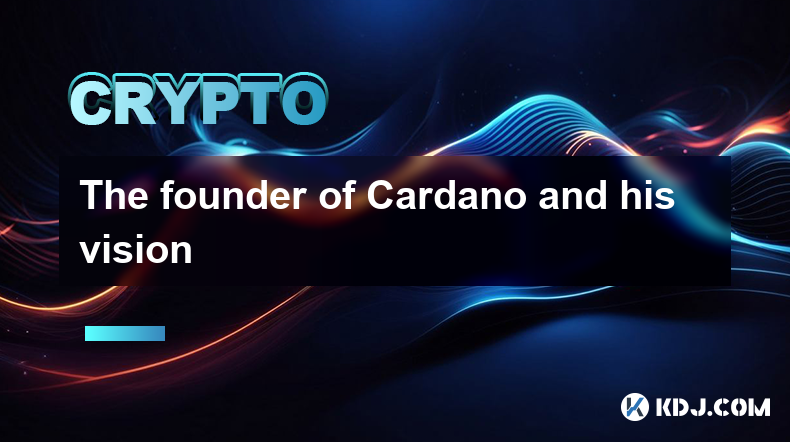
Key Points:
- Charles Hoskinson's background and journey to founding Cardano.
- Hoskinson's vision for Cardano as a third-generation blockchain.
- The key features and technologies driving Cardano's development.
- Cardano's approach to scalability, sustainability, and security.
- The role of peer review and academic rigor in Cardano's development.
- The future direction of Cardano and Hoskinson's ongoing involvement.
The Founder of Cardano and His Vision
Charles Hoskinson, the visionary behind Cardano, isn't your typical cryptocurrency founder. Unlike many who emerged from the tech world, Hoskinson's background is rooted in mathematics and philosophy. His early involvement with the cryptocurrency space included co-founding Input Output Hong Kong (IOHK), the company responsible for developing and maintaining Cardano. His academic background provides a unique perspective on blockchain technology, shaping his vision for a more robust and sustainable ecosystem.
Cardano: A Third-Generation Blockchain
Hoskinson's vision for Cardano centers around creating a third-generation blockchain, aiming to address shortcomings of previous generations. He envisions a platform that is more scalable, secure, and sustainable than Bitcoin or Ethereum. This ambition drives the continuous development and improvement of Cardano's core functionalities. His philosophy emphasizes the importance of peer review and scientific rigor in the development process, a departure from the often-haphazard approach of other projects.
Scalability, Sustainability, and Security: The Cardano Trifecta
Cardano tackles the challenges of scalability through its Ouroboros proof-of-stake consensus mechanism. This innovative approach significantly reduces energy consumption compared to proof-of-work systems, addressing the sustainability concerns often associated with cryptocurrencies. Simultaneously, the rigorous design and peer review process contribute to Cardano's enhanced security, minimizing vulnerabilities and potential exploits. Hoskinson's emphasis on these three pillars – scalability, sustainability, and security – forms the core of his vision for Cardano.
Peer Review and Academic Rigor
Unlike many cryptocurrency projects that prioritize rapid development over thorough testing, Cardano embraces a more academic approach. The development process is heavily reliant on peer review, ensuring that the codebase is thoroughly vetted before implementation. This meticulous approach enhances the reliability and security of the platform, aligning with Hoskinson's vision of a robust and trustworthy blockchain. This commitment to academic rigor sets Cardano apart in the cryptocurrency landscape.
Ouroboros: The Heart of Cardano
The Ouroboros proof-of-stake consensus mechanism is a cornerstone of Cardano's design. It allows for efficient transaction processing while drastically reducing energy consumption compared to proof-of-work systems. This makes Cardano a more environmentally friendly option within the cryptocurrency world, reflecting Hoskinson's commitment to sustainability. The algorithm’s complexity also contributes significantly to the network’s overall security.
Beyond the Technology: Cardano's Ecosystem
Hoskinson's vision extends beyond the technical aspects of Cardano. He envisions a thriving ecosystem encompassing decentralized applications (dApps), smart contracts, and a robust community. The development of Plutus, Cardano's smart contract platform, is a crucial part of this vision, enabling developers to build and deploy decentralized applications on the Cardano blockchain. This wider ecosystem is designed to foster innovation and drive adoption.
The Future of Cardano and Hoskinson's Role
The future direction of Cardano remains closely tied to Hoskinson's ongoing involvement and leadership. He continues to advocate for the platform's growth and adoption, guiding the development team and engaging with the community. His commitment to academic rigor, sustainable development, and community building is expected to shape Cardano's trajectory for years to come. He consistently emphasizes the long-term vision, prioritizing a sustainable and secure blockchain over short-term gains.
The Role of Decentralization
Decentralization is a key principle underpinning Hoskinson’s vision for Cardano. He aims to create a truly decentralized network, resistant to censorship and control by any single entity. This commitment to decentralization is reflected in Cardano's governance model and its emphasis on community participation. The network's future relies on the collective contributions and participation of its users.
Addressing the Challenges
The path to achieving Hoskinson's vision for Cardano isn't without its challenges. Competition from other blockchain platforms and the ever-evolving landscape of the cryptocurrency industry present ongoing hurdles. However, Hoskinson's commitment to research, development, and community building positions Cardano to overcome these challenges and continue to grow.
Common Questions and Answers:
Q: What is Charles Hoskinson's background before founding Cardano?
A: Charles Hoskinson has a background in mathematics and philosophy. He was involved in early cryptocurrency projects and co-founded Input Output Hong Kong (IOHK), the company that develops Cardano.
Q: What makes Cardano a "third-generation" blockchain?
A: Cardano aims to address the limitations of earlier blockchains like Bitcoin and Ethereum by focusing on scalability, sustainability, and security through its Ouroboros proof-of-stake consensus mechanism and peer-reviewed development process.
Q: How does Cardano achieve scalability?
A: Cardano uses the Ouroboros proof-of-stake consensus mechanism, which is more energy-efficient and scalable than proof-of-work systems. Further scalability solutions are continually being researched and implemented.
Q: What is the significance of peer review in Cardano's development?
A: Peer review ensures a high level of code quality and security, minimizing vulnerabilities and enhancing the overall reliability of the platform. This rigorous approach distinguishes Cardano from many other cryptocurrency projects.
Q: What is Plutus and its role in Cardano's ecosystem?
A: Plutus is Cardano's smart contract platform, enabling developers to create and deploy decentralized applications (dApps) on the Cardano blockchain, thus fostering a broader and more diverse ecosystem.
Q: What are the key challenges facing Cardano?
A: Cardano faces challenges common to the cryptocurrency space, including competition from other platforms and the constant need to adapt to the evolving technological landscape. Maintaining its decentralization while growing is also a continuous challenge.
Q: What is Hoskinson's long-term vision for Cardano?
A: Hoskinson's long-term vision encompasses a sustainable, secure, and scalable blockchain ecosystem with a thriving community of developers and users, driven by innovation and decentralized governance.
Disclaimer:info@kdj.com
The information provided is not trading advice. kdj.com does not assume any responsibility for any investments made based on the information provided in this article. Cryptocurrencies are highly volatile and it is highly recommended that you invest with caution after thorough research!
If you believe that the content used on this website infringes your copyright, please contact us immediately (info@kdj.com) and we will delete it promptly.
- Rekt, Ovie Faruq, and the Movement: How a Crypto Meme Became a Consumer Brand
- 2025-06-30 21:10:14
- BlockDAG, Crypto Loyalty, and the XRP Slide: What's the Buzz?
- 2025-06-30 21:10:14
- Cryptos to Invest in Now: Spotting the Future Giants
- 2025-06-30 20:50:12
- PENGU's Upside Rally: Decoding the Stock Potential
- 2025-06-30 21:15:12
- Arbitrum, Robinhood, and Pullback Risk: Decoding the Latest Buzz
- 2025-06-30 21:20:12
- Chainlink Price Prediction: Will LINK Hit $13 Peak or Face Correction?
- 2025-06-30 21:25:11
Related knowledge

How to customize USDT TRC20 mining fees? Flexible adjustment tutorial
Jun 13,2025 at 01:42am
Understanding USDT TRC20 Mining FeesMining fees on the TRON (TRC20) network are essential for processing transactions. Unlike Bitcoin or Ethereum, where miners directly validate transactions, TRON uses a delegated proof-of-stake (DPoS) mechanism. However, users still need to pay bandwidth and energy fees, which are collectively referred to as 'mining fe...

USDT TRC20 transaction is stuck? Solution summary
Jun 14,2025 at 11:15pm
Understanding USDT TRC20 TransactionsWhen users mention that a USDT TRC20 transaction is stuck, they typically refer to a situation where the transfer of Tether (USDT) on the TRON blockchain has not been confirmed for an extended period. This issue may arise due to various reasons such as network congestion, insufficient transaction fees, or wallet-rela...

How to cancel USDT TRC20 unconfirmed transactions? Operation guide
Jun 13,2025 at 11:01pm
Understanding USDT TRC20 Unconfirmed TransactionsWhen dealing with USDT TRC20 transactions, it’s crucial to understand what an unconfirmed transaction means. An unconfirmed transaction is one that has been broadcasted to the blockchain network but hasn’t yet been included in a block. This typically occurs due to low transaction fees or network congestio...

How to check USDT TRC20 balance? Introduction to multiple query methods
Jun 21,2025 at 02:42am
Understanding USDT TRC20 and Its ImportanceUSDT (Tether) is one of the most widely used stablecoins in the cryptocurrency market. It exists on multiple blockchain networks, including TRC20, which operates on the Tron (TRX) network. Checking your USDT TRC20 balance accurately is crucial for users who hold or transact with this asset. Whether you're sendi...

What to do if USDT TRC20 transfers are congested? Speed up trading skills
Jun 13,2025 at 09:56am
Understanding USDT TRC20 Transfer CongestionWhen transferring USDT TRC20, users may occasionally experience delays or congestion. This typically occurs due to network overload on the TRON blockchain, which hosts the TRC20 version of Tether. Unlike the ERC20 variant (which runs on Ethereum), TRC20 transactions are generally faster and cheaper, but during...

The relationship between USDT TRC20 and TRON chain: technical background analysis
Jun 12,2025 at 01:28pm
What is USDT TRC20?USDT TRC20 refers to the Tether (USDT) token issued on the TRON blockchain using the TRC-20 standard. Unlike the more commonly known ERC-20 version of USDT (which runs on Ethereum), the TRC-20 variant leverages the TRON network's infrastructure for faster and cheaper transactions. The emergence of this version came as part of Tether’s...

How to customize USDT TRC20 mining fees? Flexible adjustment tutorial
Jun 13,2025 at 01:42am
Understanding USDT TRC20 Mining FeesMining fees on the TRON (TRC20) network are essential for processing transactions. Unlike Bitcoin or Ethereum, where miners directly validate transactions, TRON uses a delegated proof-of-stake (DPoS) mechanism. However, users still need to pay bandwidth and energy fees, which are collectively referred to as 'mining fe...

USDT TRC20 transaction is stuck? Solution summary
Jun 14,2025 at 11:15pm
Understanding USDT TRC20 TransactionsWhen users mention that a USDT TRC20 transaction is stuck, they typically refer to a situation where the transfer of Tether (USDT) on the TRON blockchain has not been confirmed for an extended period. This issue may arise due to various reasons such as network congestion, insufficient transaction fees, or wallet-rela...

How to cancel USDT TRC20 unconfirmed transactions? Operation guide
Jun 13,2025 at 11:01pm
Understanding USDT TRC20 Unconfirmed TransactionsWhen dealing with USDT TRC20 transactions, it’s crucial to understand what an unconfirmed transaction means. An unconfirmed transaction is one that has been broadcasted to the blockchain network but hasn’t yet been included in a block. This typically occurs due to low transaction fees or network congestio...

How to check USDT TRC20 balance? Introduction to multiple query methods
Jun 21,2025 at 02:42am
Understanding USDT TRC20 and Its ImportanceUSDT (Tether) is one of the most widely used stablecoins in the cryptocurrency market. It exists on multiple blockchain networks, including TRC20, which operates on the Tron (TRX) network. Checking your USDT TRC20 balance accurately is crucial for users who hold or transact with this asset. Whether you're sendi...

What to do if USDT TRC20 transfers are congested? Speed up trading skills
Jun 13,2025 at 09:56am
Understanding USDT TRC20 Transfer CongestionWhen transferring USDT TRC20, users may occasionally experience delays or congestion. This typically occurs due to network overload on the TRON blockchain, which hosts the TRC20 version of Tether. Unlike the ERC20 variant (which runs on Ethereum), TRC20 transactions are generally faster and cheaper, but during...

The relationship between USDT TRC20 and TRON chain: technical background analysis
Jun 12,2025 at 01:28pm
What is USDT TRC20?USDT TRC20 refers to the Tether (USDT) token issued on the TRON blockchain using the TRC-20 standard. Unlike the more commonly known ERC-20 version of USDT (which runs on Ethereum), the TRC-20 variant leverages the TRON network's infrastructure for faster and cheaper transactions. The emergence of this version came as part of Tether’s...
See all articles





















